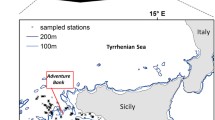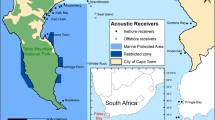Abstract
The Mexican Caribbean is considered one of the most important sites for whale shark aggregations. Whale shark groups of over 300 individuals have been recorded frequently. There is little published information regarding the ecology of the whale shark in Mexico, and the role that the Mexican Caribbean plays as habitat for this species. This area has been recognized as important for the whale shark and therefore it is necessary to determine the environmental factors that shape the distribution of these animals. The aim of this study was to identify key environmental factors associated with whale shark feeding aggregations and to determine the patterns in habitat suitability for whale sharks in the Mexican Caribbean through the modeling approach of maximum entropy. Whale shark data obtained for this study included 250 records during April to September (2008–2012). The MaxEnt model performed better than random and produced an area under the curve (AUC) score of 0.946. Primary productivity and sea surface temperature were the variables most strongly related to whale shark sightings. The model predicted a high suitability in areas located to the north of Isla Contoy and the offshore area east of Isla Contoy named “Afuera” (>0.75), with medium suitability north of Cabo Catoche (>0.5) and lower suitability for the northeast of Cabo Catoche (<0.5). The habitat suitability maps also indicated seasonal variations, showing a higher prediction of whale shark sightings during the rainy season (June to October), when primary productivity is higher in the area.





Similar content being viewed by others
References
Afonso P, McGinty N, Machete M (2014) Dynamics of whale shark occurrence at their fringe oceanic habitat. PLoS ONE 9(7):e102060. doi:10.1371/journal.pone.0102060
Antochiw-Alonzo DM (2010) Mamíferos Acuáticos. In: Durán R, Méndez M (eds) Biodiversidad y Desarollo Humano en Yucatan, CICY, PPD-FMAM, CONABIO, SEDUMA., pp 278–280
Anderson RC, Ahmed H (1993) The shark fisheries of the Maldives. MOFA, Malé and FAO, Rome
Beckley LE, Cliff G, Smale MJ, Compagno LJ (1997) Recent strandings and sightings of whale sharks in South Africa. Environ Biol Fish 50(3):343–348
Cárdenas-Palomo N, Herrera-Silveira J, Reyes Ó (2010) Distribución espacio-temporal de variables fisicoquímicas y biológicas en el hábitat del tiburón ballena Rhincodon typus (Orectolobiformes: Rhincodontidae) al norte del Caribe Mexicano. Rev Biol Trop 58(1):399–412
Cárdenas-Palomo N, Herrera-Silveira J, Velázquez-Abunader I, Reyes O, Ordonez U (2014) Distribution and feeding habitat characterization of whale sharks Rhincodon typus in a protected area in the north Caribbean Sea. J Fish Biol. doi:10.1111/jfb.12589
Clark E, Nelson DR (1997) Young whale sharks, Rhincodon typus, feeding on a copepod bloom near La Paz, Mexico. Environ Biol Fish 50:63–73
Colman JG (1997) A review of the biology and ecology of the whale shark. J Fish Biol 51:1219–1234
Compagno LJV (1984) Sharks of the World, Part 1: Hexanchiformes to Lamniformes. FAO Fisheries Synopsis 125. Rome
Croll DA, Marinovic B, Benson S, Chavez FP, Black N, Ternullo R, Tershy BR (2005) From wind to whales: trophic links in a coastal upwelling system. Mar Ecol Prog Ser 289:117–130
Cuevas E, González B, Segovia A, Sosa J (2010) Tortugas marinas: Poblaciones y hábitats críticos. In: Durán R, Méndez M (eds) Biodiversidad y Desarrollo Humano en Yucatán, CICY, PPD-FMAM, CONABIO, SEDUMA., pp 262–263
de la Parra-Venegas R, Hueter R, González-Cano J, Tyminski J, Remolina JG, Maslanka M, Ormos A, Weig L, Carlson B, Dove A (2011) An unprecedented aggregation of whale sharks, Rhincodon typus, in Mexican coastal waters of the Caribbean Sea. PLoS ONE 6, e18994. doi:10.1371/journal.pone.0018994
Duffy CAJ (2002) Distribution, seasonality, lengths, and feeding behavior of whale sharks (Rhincodon typus) observed in New Zealand waters. NZ J Mar Freshw Res 36:565–570
Eckert S, Stewart B (2001) Telemetry and satellite tracking of whale sharks, Rhincodon typus, in the Sea of Cortez, Mexico, and North Pacific Ocean. Environ Biol Fish 60:299–308
Elith J, Leathwick JR (2009) Species distribution models: ecological explanation and prediction across space and time. Annu Rev Ecol Evol Syst 40:677–697
Elith J, Phillips SJ, Hastie T, Dudík M, Chee YE, Yates CJ (2011) A statistical explanation of MaxEnt for ecologists. Divers Distrib 17(1):43–57
Franklin J (2009) Mapping species distributions: spatial inference and prediction. Press, Cambridge University
Graham RT, Roberts CM (2007) Assessing the size, growth rate and structure of a seasonal population of whale sharks (Rhincodon typus, Smith 1828) using conventional tagging and photo identification. Fish Res 84(1):71–80
Graham RT, Roberts CM, Smart JC (2006) Diving behaviour of whale sharks in relation to a predictable food pulse. J R Soc Interface 3:109–116
Graham RT, Witt MJ, Castellanos DW, Remolina F, Maxwell S, Godley BJ, Hawkes LA (2012) Satellite tracking of manta rays highlights challenges to their conservation. PloS ONE 7(5):e36834
Guisan A, Thuiller W (2005) Predicting species distribution: offering more than simple habitat models. Ecol Lett 8:993–1009
Hacohen-Domené A, Galvan-Magana F, Ketchum-Mejia J (2006) Abundance of whale shark (Rhincodon typus) preferred prey species in the southern Gulf of California, Mexico. Cybium 30(4):99–102
Heyman WD, Graham RT, Kjerfve B, Johannes RE (2001) Whale sharks Rhincodon typus aggregate to feed on fish spawn in Belize. Mar Ecol Prog Ser 215:275–282
Hijmans RJ, Elith J (2011) Species distribution modeling with R Introduction. http://cran.r-project.org/web/packages/dismo/vignettes/dm.pdf. Accessed 12 Nov 2013
Hoffman W, Fritts TH, Reynolds RP (1981) Whale sharks associated with fish schools off south texas. Northeast Gulf Sci 5(1):55–57
Hueter RE, Tyminski JP, de la Parra R (2013) Horizontal movements, migration patterns, and population structure of whale sharks in the Gulf of Mexico and Northwestern Caribbean Sea. PLoS ONE 8(8), e71883. doi:10.1371/journal.pone.0071883
Jonahson M, Harding S (2007) Occurrence of whale sharks (Rhincodon typus) in Madagascar. Fish Res 84(1):132–135
Ketchum JT (2003) Distribución espacio-temporal y ecología alimentaria del tiburón ballena (Rhincodon typus) en la bahía de La Paz y zonas adyacentes en el Suroeste del Golfo de California . Dissertation, Instituto Politécnico Nacional. Centro Interdisciplinario de Ciencias Marinas
Ketchum JT, Galván-Magaña F, Klimley AP (2012) Segregation and foraging ecology of whale sharks, Rhincodon typus, in the southwestern Gulf of California. Environ Biol Fish 96:449–795
Kirk JTO (1994) Light and photosynthesis in aquatic ecosystems. Cambridge University Press, New York
Last PR, Stevens JD (1994) Sharks and rays of Australia. CSIRO, Melbourne
Merino IM (1992) Afloramiento en la Plataforma de Yucatán. Estructura y Fertilización. Dissertation, Instituto de Ciencias del Mar y Limnología. Universidad Nacional Autónoma de México
McKinney J, Hoffmayer E, Wu W, Fulford R, Hendon J (2012) Feeding habitat of the whale shark Rhincodon typus in the northern Gulf of Mexico determined using species distribution modelling. Mar Ecol Prog Ser 458:199–211. doi:10.3354/meps09777
Motta PJ, Maslanka M, Hueter RE, Davis RL, de la Parra R, Mulvany SL, Habegger ML, Strother JA, Mara KR, Gardiner JM, Tyminski JP, Zeigler LD (2010) Feeding anatomy, filter-feeding rate, and diet of whale sharks Rhincodon typus during surface ram filter feeding off the Yucatan Peninsula, Mexico. Zoology 113:199–212
Nelson JD, Eckert SA (2007) Foraging ecology of whale sharks (Rhincodon typus) within Bahía de Los Angeles, Baja California Norte, México. Fish Res 84(1):47–64
Norman BM (1999) Aspects of the biology and ecotourism industry of the whale shark Rhincodon typus in north-western Australia. Dissertation, Murdoch University
Norman BM (2000) 2000 IUCN red list of threatened species. . IUCN Gland, Switzerland
Pearson RG (2007) Species’ distribution modeling for conservation educators and practitioners. Lessons Conserv 3:54–89
Phillips SJ, Anderson RP, Schapire RE (2006) Maximum entropy modeling of species geographic distributions. Ecol Model 190(3):231–259
Pravin P (2000) Whale shark in the Indian coast-need for conservation.Current. Science 79(3):310–315
Ramírez-Macías D, Meekan M, La ParraVenegas R, Remolina-Suárez F, Trigo-Mendoza M, Vázquez-Juárez R (2012) Patterns in composition, abundance and scarring of whale sharks Rhincodon typus near Holbox Island, Mexico. J Fish Biol 80(5):1401–1416
Remolina Suárez JF, Pérez Ramírez JJ, González JM, De la Parra R, Betancourt N, Trigo M, González L, Antele-Marcial J (2007) Whale shark management strategies, with the participation of local stakeholders, in Yum Balam, Mexico. In: The First International Whale Shark Conference: Promoting International Collaboration in Whale Shark Conservation, Science and Management. Conference Overview, Abstracts and Supplementary Proceedings. Irvine TR, Keesing JK (eds) CSIRO Marine and Atmospheric Research, Australia, pp 31–35
Robertson MP, Peter CI, Villet MH, Ripley BS (2003) Comparing models for predicting species’ potential distributions: a case study using correlative and mechanistic predictive modelling techniques. Ecol Model 164(2):153–167
Robinson R, Crick HQP, Learmonth JA, Maclead IMD, Thomas CD, Bairlein F, Forchhammer MC, Francis CM, Gill JA, Godley BJ, Harwood J, Hays GC, Huntley B, Hutson AM, Pierce GJ, Rehfisch MM, Sims DW, Santos MB, Sparks TH, Stroud DA, Visser ME (2009) Travelling through a warming world: climate change and migratory species. Endanger Species Res 7:87–99
Robinson DP, Jaidah MY, Jabado RW, Lee-Brooks K, El-Din NMN, Malki AAA, Elmeer K, McCormick PA, Henderson AC, Pierce SJ (2013) Whale sharks, Rhincodon typus, aggregate around offshore platforms in Qatari waters of the Arabian Gulf to feed on fish spawn. PLoS ONE 8, e58255. doi:10.1371/journal.pone.0058255
Rowat D, Gore M (2007) Regional scale horizontal and local scale vertical movements of whale sharks in the Indian Ocean off Seychelles. Fish Res 84(1):32–40
Rowat D, Gore M, Meekan MG, Lawler IR, Bradshaw CJ (2009) Aerial survey as a tool to estimate whale shark abundance trends. J Exp Mar Biol Ecol 368(1):1–8
Sequeira A, Mellin C, Bradshaw C, Rowat D, Meekan M (2012) Ocean-scale predictions of whale shark distribution. Divers Distrib 18:504–518
Sequeira AM, Mellin C, Fordham DA, Meekan MG, Bradshaw CJ (2013) Predicting current and future global distributions of whale sharks. Glob Change Biol 20(3):778–789. doi:10.1111/gcb.12343
Sims DW, Quayle VA (1998) Selective foraging behaviour of basking sharks on zooplankton in a small-scale front. Nature 393(6684):460–464
Speed CW, Meekan MG, Rowat D, Pierce SJ, Marshall AD, Bradshaw CJA (2008) Scarring patterns and relative mortality rates of Indian Ocean whale sharks. J Fish Biol 72(6):1488–1503
Taylor G (1994) Whale sharks, the giants of ningaloo reef. Haper Collins, New York
Taylor JG (1996) Seasonal occurrence, distribution and movements of the whale shark, Rhincodon typus, at Ningaloo Reef, Western Australia. Mar Freshwater Res 47:637–642
Taylor JG, Pearce AF (1999) Ningaloo Reef currents: implications for coral spawn dispersal, zooplankton and whale shark abundance. J Roy Soc W A 82:57–65
Taylor JG (2007) Ram filter-feeding and nocturnal feeding of whale sharks (Rhincodon typus) at Ningaloo Reef, Western Australia. Fish Res 84(1):65–70
Wiley EO, McNyset KM, Peterson AT, Robins CR, Stewart AM (2003) Niche modeling and geographic range predictions in the marine environment using a machine-learning algorithm. Oceanography 16(3):120–127
Wilson SG, Taylor JG, Pearce AF (2001) The seasonal aggregation of whale sharks at Ningaloo Reef, Western Australia: currents, migrations and the El Nino/Southern Oscillation. Environ Biol Fish 61:1–11
Wilson SG, Polovina JJ, Stewart BS, Meekan MG (2006) Movements of whale sharks (Rhincodon typus) tagged at Ningaloo Reef, Western Australia. Mar Biol 148:1157–1166
Ziegler J (2010) Assessing the sustainability of whale shark tourism: A case study of Isla Holbox, Mexico. Dissertation, University of Victoria
Acknowledgments
This work was supported by MEX-US (University of California-CONACYT) in the project “Determination of movement, habitat use, filtration mechanics and diet/food preference of manta rays off the Yucatan peninsula”. Also thanks to CONACYT and PIFI- IPN for fellowships to AHD, and Instituto Politécnico Nacional (COFAA, EDI) granted to FGM. Thank to MVZ Francisco Remolina Suárez, Director Reserva de la Biosfera Tiburón Ballena to develop this project in the protected area.
Author information
Authors and Affiliations
Corresponding author
Rights and permissions
About this article
Cite this article
Hacohen-Domené, A., Martínez-Rincón, R.O., Galván-Magaña, F. et al. Habitat suitability and environmental factors affecting whale shark (Rhincodon typus) aggregations in the Mexican Caribbean. Environ Biol Fish 98, 1953–1964 (2015). https://doi.org/10.1007/s10641-015-0413-5
Received:
Accepted:
Published:
Issue Date:
DOI: https://doi.org/10.1007/s10641-015-0413-5




